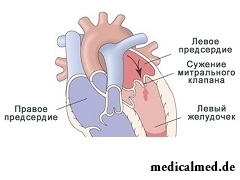





Mitral stenosis
The mitral stenosis or stenosis of the mitral valve is a considerable narrowing of the atrioventricular opening connecting the left auricle and a left ventricle of heart. In a junction the mitral valve consisting of two shutters is located. At a mitral stenosis of a shutter of the valve are thickened, growing together with each other, and reduce the opening size.
The area of the left atrioventricular opening in healthy heart of 4-6 cm2. Clear disturbances in cordial blood circulation appear at reduction of the area of an opening to 1,0-1,5 cm2. When the size of the area less than 1 cm2, operational treatment is shown.
The mitral stenosis or stenosis of the mitral valve is classified as the acquired heart disease. It forms more often at women, it is preferential at young or middle age. In most cases a stenosis of the mitral valve – a consequence of rheumatism.
Mitral stenosis: symptoms
Long time, at small extent of development, symptoms of a mitral stenosis can not be shown absolutely (latent form). At this stage the stenosis of the mitral valve is distinguished only at kliniko-tool researches. Even the insignificant stenosis of the mitral valve progresses usually owing to tendency of patients to recurrent rheumatism.
The first symptoms of a mitral stenosis appear at its progressing when it is noted:
- Pain in heart, a cardiopalmus at increase in an exercise stress;
- Asthma at a usual exercise stress or in a prone position;
- Increased fatigue;
- Frequent diseases of upper respiratory tracts (bronchitis);
- Hypostasis of legs;
- Discomfort in a breast;
- Characteristic cough with a pneumorrhagia;
- Bluish-pink shade of cheeks and lips (mitral flush);
- Trembling of a thorax in heart.
Standard age of manifestation of symptoms of 40-50 years, but they meet at earlier age and in infancy. In the presence of such symptoms it is necessary to see a doctor at once. As a result of medical examination and inspection the doctor reveals additional or secondary symptoms of a mitral stenosis:
- Arrhythmia;
- Cordial noise;
- Pulmonary hypertensia;
- Stagnation in lungs;
- Formation of blood clots.
Degrees of a mitral stenosis
In 1955 the Soviet scientists A. N. Bakulev and E. A. Damir offered classification of degrees of a mitral stenosis by expressiveness of an asthma. This scheme with success is applied in modern medicine by most of specialists.
Extent of narrowing of an atrioventricular opening and disturbance of a hemodynamics in a small circle are shown by an asthma of five stages:
- I – there is no asthma. Full compensation of blood circulation, complaints is not present. By results of inspection symptoms, characteristic of a mitral stenosis, are found. The area of a mitral orifice is 3-4 cm2, the left auricle - no more than 4 cm;
- II – do not have an asthma at rest, it arises at an exercise stress. Relative circulatory unefficiency, slight increase of venous pressure. The area of a mitral orifice is up to 2 cm2, the left auricle of 4-5 cm;
- The III degree of a mitral stenosis – a constant asthma at rest. The expressed initial stage of disturbance of blood circulation. Primary phenomena of stagnation of blood in small and big circles. Increase in the size of heart and liver. Substantial increase of venous pressure. The area of a mitral orifice is 1-1,5 cm2, the left auricle of 5 cm and more;
- IV – a constant heavy asthma. Strongly expressed circulatory unefficiency, considerable stagnation of blood in a big circle, a ciliary arrhythmia. Considerably the heart increased in sizes, the big sizes a dense liver. High venous pressure. The area of a mitral orifice less than 1 cm2, the left auricle is more than 5 cm;
- V – asthma of extreme severity, round-the-clock. The circulatory unefficiency is terminal dystrophic. Most increased sizes of heart and liver. Very high venous pressure. Accumulation of liquid in an abdominal cavity, severe peripheral hypostases. The area of a mitral orifice is much less than 1 cm2, the left auricle is essential more than 5 cm.

Mitral stenosis: treatment
The choice of tactics of treatment depends on degree of a mitral stenosis:
- Medicines are not appointed to the I stages of asymptomatic course of a mitral stenosis. Rather regular observation at the cardiorheumatologist and observance of its appointments and recommendations;
- In the presence of insignificant clinical manifestations, appoint diuretics and beta-blockers to the II-III stages. Carry out prevention of a recurrence of an infectious endocarditis and rheumatism;
- At the IV stage at significant increase in sizes of the left auricle, a paroxysmal form of a ciliary arrhythmia and a thromboembolism regular reception of indirect anticoagulants is necessary. At the same time treatment of a thromboembolism and ciliary arrhythmia according to standard schemes is carried out;
- At the IV-V stage at reduction of the sizes of an atrioventricular opening to 1,0-1,2 cm2, the recurrent thromboembolism, heavy pulmonary hypertensia needs surgical treatment of a mitral stenosis.
Operations on treatment of a stenosis of the mitral valve were one of the first operations on heart. Thanks to it long-term experience of operational treatment of a mitral stenosis is acquired. The following types of operations are developed and practice:
- Komissurotormiya;
- The closed komissurotormiya or balloon valvuloplasty;
- Annuloplasty. Opened (it is often carried out during an open komissurotormiya) or the closed transvenous;
- Prosthetics. Full replacement of the natural valve on artificial (mechanical or biological).
At a disease of a mitral stenosis big exercise stresses, intellectual and emotional pressure, strong cooling are contraindicated. With development of complications total loss of working capacity is observed.
Average life expectancy of lefthanders is less, than right-handed persons.

The phenomenon of improvement of a condition of the patients at administration of drugs who are not containing active agents, so-called effect of placebo is known...
Section: Articles about health
Beauty shop – the place which is associated only with positive emotions: joy, pleasure, relaxation. However visit of salon where work with biological material of clients, not always harmlessly is conducted. Today it is known Bol...
Section: Articles about health
It is known that the person for 80% consists of water which participates in all processes of an organism. The person loses liquid daily – as a result of sweating, breath, an urination, and its insufficient completion due to various reasons can lead to dehydration of varying severity. Dehydration (dehydration) occurs already in case of loss of liquid in number of 1% of body weight and can result both in easy thirst, and by the death. In time to notice signs обезвож...
Section: Articles about health
More than a half of the married couples which faced prostatitis – leave. The new broadcast "Female View of Prostatitis" will help to learn...
Section: Articles about health
Any person who faced a disease knows that treatment costs expensive. It belongs also to consultations of qualified specialists, and to the diagnostic procedures which are not included in the list of obligatory medical services. Question of cost of medicinal Wednesday...
Section: Articles about health
The body of the person almost for 60% consists of water. It is so important for normal functioning of an organism that loss of only one and a half percent of liquid already leads to the most unpleasant effects. The problems connected with deficit of water can overtake also the healthiest person if he, for example, spends several hours under the scorching sun, without having taken with themselves drink, but is very simple to correct health in this case. It is much more difficult to minimize effects of other reasons about...
Section: Articles about health
A lot of things depend on a condition of a backbone in a human body, a backbone - not only a support for a body, it also contain...
Section: Articles about health
New year, wedding, birthday, office party – an occasion to drink at the Russian person will always be. How to reduce a negative impact of alcohol by an organism and to avoid a condition of strong intoxication? The most correct council – to refuse the use spirits напитк...
Section: Articles about health
Practice of use of table salt in the therapeutic purposes contains not one century. Applications which do by means of the fabric impregnated with saline solution are considered especially effective. They have antibacterial and antiinflammatory effect, help to heal wounds, exempt fabrics from excess liquid. Hypertonic salt solution of potassium chloride is applied outwardly at many morbid conditions. Let's tell about the most known of them....
Section: Articles about health
You heard that laughter prolongs life? To establish longevity direct link with sincere fun to researchers yet not удалос...
Section: Articles about health
Memory is an ability of the central nervous system to fix, keep and as necessary to reproduce information on knowledge or skills received by the person or an animal during life. The mechanism of this process is up to the end not studied....
Section: Articles about health
One of the useful properties presented to the person by the nature is ability to feel fear. This ability is designed to signal about approach of a dangerous situation and to help to avoid in advance it to keep life. However if the fear is persuasive and is not reasonable, it can seriously limit possibilities of the person in respect of socialization and self-realization. Such pathological fear is called a phobia....
Section: Articles about health
What is in our understanding weeds? It plants which are considered to be suitable only for compost pits and feeding жи...
Section: Articles about health
The dietology, as well as other sciences, does not stand still. Food stuffs are exposed to comprehensive study, and scientists obtain new information on their properties and influence on a human body. Unfortunately, this reasonable and natural process from time to time д...
Section: Articles about health
"Epilepsy" doctors made the diagnosis in antique times. Displays of an illness and pattern of its development are very well studied. However for nonspecialists this disease remains to not less mysterious, than in the ancient time. Many delusions are connected with epilepsy, and it sometimes very unpleasantly affects quality of life of patients and their relatives. In this article we will try to dispel the most known of similar myths....
Section: Articles about health
Life of the modern child is extremely active and difficult. Information strain which is experienced by the school student and did not dream the pupil...
Section: Articles about health
In consciousness of our many compatriots idea that folk remedies if are no more effective, than medicinal "chemistry" strongly took roots, then are precisely less harmful. Unfortunately, it is not always fair: some receptions treating...
Section: Articles about health
Several decades ago the basil (the district khan, реан, Reagan) was considered as a part of the Caucasian or east cuisine, but today it strongly took the place on tables of Russians. Greens of this plant possess a strong, pleasant smell and specific fresh taste because of which it is included almost in all dry mixes of spicy herbs, and also give to meat and fresh fish dishes....
Section: Articles about health
All diseases from nerves – in this joke a big element of truth, are said by doctors. Constant stresses lead body to decrease in protective forces...
Section: Articles about health
Coffee – favourite drink of many. For the last decades it more than once already declared very harmful, extremely useful and even necessary for normal life activity. In spite of the fact that this product became for us usual for a long time, exists much...
Section: Articles about health
The cosmetics intended for improvement of a condition of skin, nails and hair are used by each woman. Expenses on regular acquisition of the fashionable widely advertized products of well-known companies for many become very notable and significantly burden the family budget. Meanwhile, there is a number of inexpensive pharmaceutical drugs which can quite be applied in the cosmetic purposes. At the same time the effect of their use is often more noticeable, than result of use of the most expensive...
Section: Articles about health
Herpes simplex of the first type (the infectious disease which is shown periodic bubble rashes on is called...
Section: Articles about health
Wood louse – the ordinary-looking unpretentious plant extended in all territory of our country. It quickly expands, and sometimes fills sites, bringing a lot of chagrin to gardeners. Perhaps, they would be upset less if knew that the wood louse is the prices...
Section: Articles about health
For the help to doctors in the choice of optimal solutions for treatment of various diseases the Cochrane scientific organization (Cochrane) conducts joint researches with representatives of scientific community around the world. The analysis of a series of the conducted researches of the drug Oscillococcinum® relating to group of cold remedies became one of the last methanolyses....
Section: Articles about health
The depression not without reason is considered one their main troubles of our century: for scientific and technical progress, acceleration of rate of life and a surplus...
Section: Articles about health
Feeding by a breast - the integral part of ideal motherhood allowing to come into contact with the kid and to create to it healthy immunity since early years. Nevertheless, this important process in life of mother and child can be saddened laktostazy − by a delay of milts...
Section: Articles about health
The summer of this year in Russia was very ambiguous. Regions suffered from a merciless heat, from pouring rains, the hail from time to time dropped out, then there was again a heat which alternated with rainfall again. Many people suffer from such sharp changes of weather. Even flu epidemics and a SARS were recorded....
Section: Articles about health
